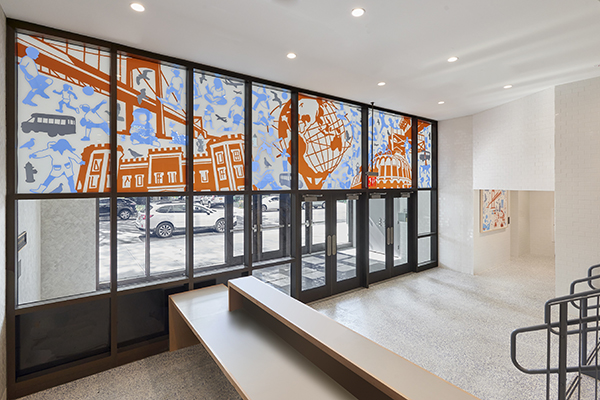
Public Art for Public Schools functions as a unit within the New York City School Construction Authority. Founded in 1989, this program oversees the creation of site-specific projects for newly built schools. It also manages the preservation of nearly 2,000 existing artworks in the New York City Department of Education’s collection throughout the five boroughs. PAPS mission is to enrich students’ learning environments by equipping schools with artworks that will elevate the school atmosphere, serve as exceptional educational tools for teachers and ignite imagination and inspiration in students.
The artwork
Artist Justin Kim created a mural for The Alley Pond School, a public school in Bayside, Queens, as a project for the PAPS initiative. The mural’s glass surface depicts different individuals engaging in various activities such as reading books, playing the violin and shooting basketballs. Creating an uplifting presence in the school, the artwork serves as a constant reminder to the students that they are capable of pursuing whatever they want, anywhere in the world.
The school underwent major expansion, adding additional art and music rooms and a science resource room. This artwork also serves as a promotional piece for these enhancements. In addition, the mural also showcases iconic city landmarks, including the historic Queensboro Bridge, which connects Manhattan and Queens. The bold contrast between the bright orange and vivid blue tones creates a lively and welcoming entryway for students, staff and visitors.
Pulp Studio's involvement
For this project, Pulp Studio supplied seven panels of glass, using 9/16-inch D2G custom graphic tempered glass measuring 70 3/4-inches tall to illustrate the graphics. D2G is a direct to glass digitally printed image that uses ceramic inks that are fired onto the surface of the glass. By utilizing D2G with ceramic frit, the vibrant hues in this project will not fade over time. The process for printing on glass is highly complex due to many factors uncommon in conventional printing like transparency or translucency, white ink and size, making it a difficult practice that requires extreme attention to detail. Throughout this process, Pulp was able to print the unique, vibrant artwork onto each glass panel.
Pulp Studio has additional projects with PAPS underway, which are scheduled to be completed later this year.


